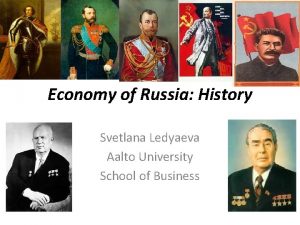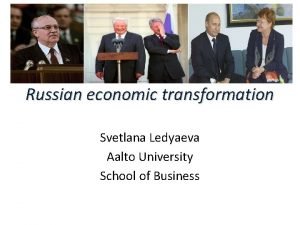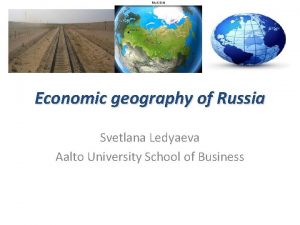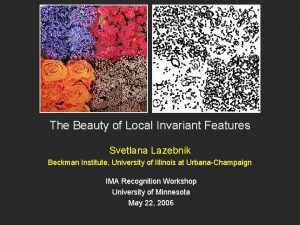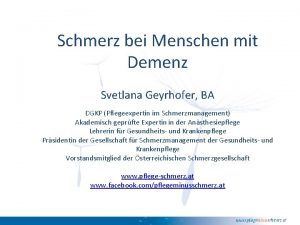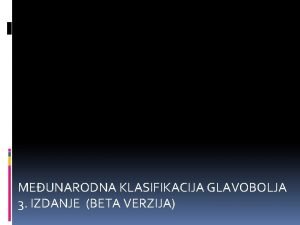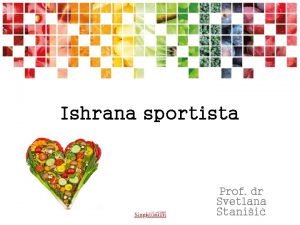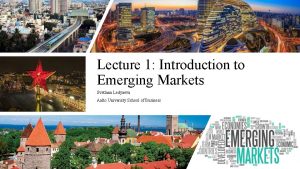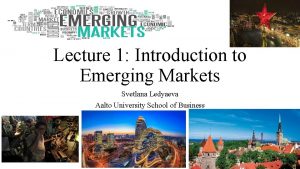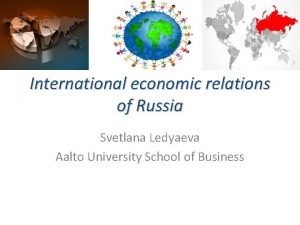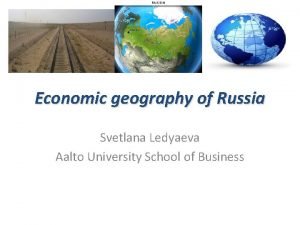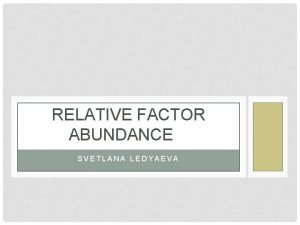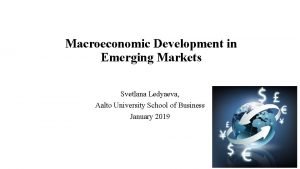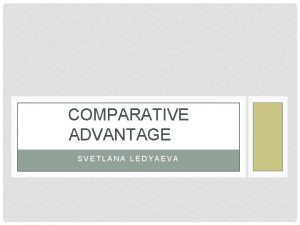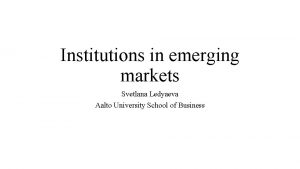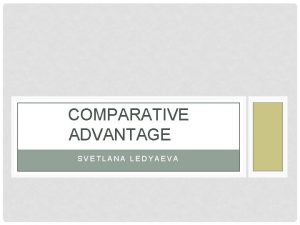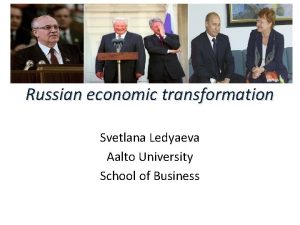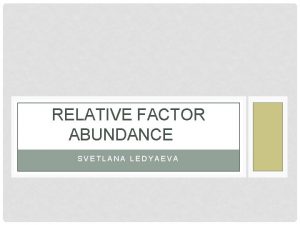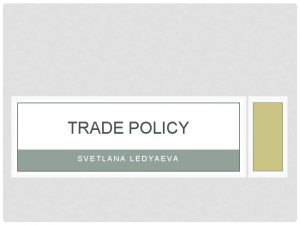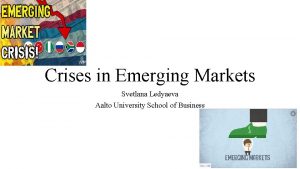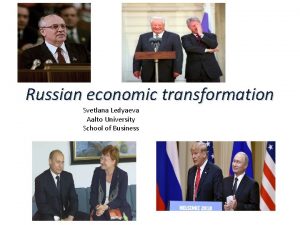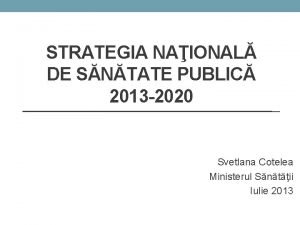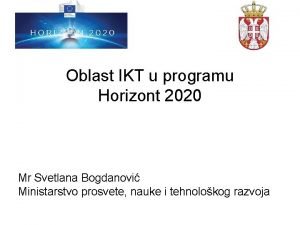INTRODUCTION SVETLANA LEDYAEVA JANUARY 2020 SECOND LECTURER Ph





























- Slides: 29

INTRODUCTION SVETLANA LEDYAEVA, JANUARY 2020

SECOND LECTURER Ph. D Sinikka Parviainen: • Analyst, East office • Contact details: sinikka. parviainen@eastoffice. fi 2/25

THIRD LECTURER Ph. D Saara Tamminen: • Leading specialist in Sitra's Climate solutions tean • Contact details: saara. tamminen@sitra. fi 3/25

GRADING (1) Exam 50 % (compulsory to pass the course) Wil consist of: 5 small essay questions (about definitions and basic concepts of the course). For each question you can get maximum 5 points. 1 exercise question for which you can get maximum 10 points. 1 big essay question for which you can get maximum 15 points. Here you will need to describe in detail selected concept of the course. 4/25

GRADING (2) Reflection paper on one of the reading items 15 % Instructions can be found on the My. Courses website. 5/25

GRADING (3) Term paper 35 % (compulsory to pass the course) • Create a team of 2 persons or write individually • Think of a research question, not research topic • Choose research methodology and present draft results during last lecture • 15 mins per presentation + time for comments • Consider the feedback and finalize your term paper 6/25

GRADING (3) Term paper 35 % (compulsory to pass the course) Examples of past research questions: • How trade policies have affected the imports of cars to Finland? • Determinants of Foreign Direct Investments to sub-Saharan Africa? • Impact of EU membership on the new members' trade? • How trade has affected the incomes of the poorer versus the richer in developed countries? Other ideas and suggestions downloadable from My. Course 7/25

GRADING (3) Term paper 35 % (compulsory to pass the course) • Deadline for sending the main research question and name of people in your research team to Svetlana Ledyaeva(svetlana. Ledyaeva@aalto. fi): Monday 20. 01. 2020 at 23. 59. • Presentation of draft term papers February 13, 2020, last lecture. • Deadline for sending the full Term Papers to Katariina: Monday 24. 2. 2020 at 23. 59. 8/25

WHAT DO WE WANT TO EXPLAIN? Real analysis vs. monetary analysis Real analysis: • Why trade takes place? • Implications of commodity and factor price changes on real variables such as labor and capital? • Benefits from international trade? • Effects of trade restrictions and trade agreements on economies? Focus on equilibrium determination and change in real trade flows and welfare 9/25

-6 ric he r ilw ra ay al d an as . . h sp ec tc , e pr od ag sl tic eu ac m ar th an ac al m ot s, e is w ils hi rn uc &t ne itu ts ra ry re m &e b w Ap ed ay qu di pa ip rs n m r Ap g, el e & pa m nt cl at , e re ot tre tc l& h. ss ac cl ot e c s, es h ac et so c. ce rie s s so Pr k n& rie ec s io cr no us Fr ui tk an ta n& d nd se cr nu m i-p ts , e re ci tc ou Fe. s r til Zi st i z on nc er es s an C & Sh d op m ar ip e p tic ta er s, ls le an bo O s d at pt th ar s ic er al an tic eo , m le d f ea s flo th su at e in re g of g, st ru m ed ct ur ic es al. e W t c. oo in Iro d st n an r. an d d ar st tic ee le l s of w Pa Pu oo pe d lp ra of nd w oo pa d pe rb oa rd Fu ct El e -4 Ph re O er &o ue ls th to no lf ra in e s tie od i M -2 hi cl es Ve m om C FACTS TO BE EXPLAINED 1: INTER-INDUSTRY SPECIALIZATION 10 8 6 4 2 0 -8 Figure: Net exports of Finland 2018 (billion USD) 10/25

FACTS TO BE EXPLAINED 1: INTER-INDUSTRY SPECIALIZATION • Competitive general equilibrium theory, the backbone of the (classical) trade theories • We'll use mostly the simplest two-industry versions of theory. • Production possibility frontier = possible combinations of output with full capacity • Shape of the production possibility frontier affected by the availability of resources in the economy, technological knowledge (effectively used) and inter-sectoral differences in technologies. • These can differ across countries and lead to the absolute/comparative advantage of nations. 11/25

FACTS TO BE EXPLAINED 1: INTER-INDUSTRY SPECIALIZATION • Classical trade theories focus on the supply side determinants of inter-industry trade patterns, e. g. factor endowments. • Classical trade theories also emphasize the structural changes implied by e. g. reductions of trade barriers and international transport costs. • Welfare implications for trade policy, such as tariffs, quantitative restrictions or import quotas, tariff-quota systems and anti-dumping policies 12/25

THE CLASSICAL TRADE THEORIES TO EXPLAIN INTER-INDUSTRY SPECIALIZATION • Lecture 2: Ricardian theory of Comparative advantage (from year 1817) • Lecture 3: Factor intensity and the Heckscher-Ohlin model (from year 1933) + Stolper-Samuelson proposition and Rybczynski proposition • Lecture 4: Trade policy: tariffs, quotas and Non-tariff measures (with perfect competition models) 13/25

FACTS TO BE EXPLAINED 2: INTRA-INDUSTRY TRADE • Despite obvious inter-industry specialization various goods and services are both exported and imported. • Exports of Nokia phones, import of i. Phones • A growing share of world trade is intra-firm trade. About 60 percent of US imports from EU were trade within multinationals in 2009. (Lanz & Miroudot, 2011) 14/25

Export Fu rs ur lf ia ic tif ar ct uf a s ur e es nc ta ic a c. eo f er m e. n. th ub s an m ls s s al . c. et er e os , ar tic le s t, in , e tc C ct st be as oi da in m Al bu nd la ke ic N t, en m ce c. et at he r al or ig ro du al im an s, le m d an try du s in ic al p of he m C ts uc illi ng ns ki en ov nw no , s d an de s hi lt fe m r, te an d pl as ns ki e, on St e th pr od of ry s aw R in g, ad d ai D ct du Pr o W FACTS TO BE EXPLAINED 2: INTRA-INDUSTRY TRADE 1200 1000 800 600 400 200 0 Import Figure: Finland, exports and imports of some product categories 2018 (million USD) 15/25

FACTS TO BE EXPLAINED 2: INTRA-INDUSTRY TRADE, CEREALS 2017 16/25

FACTS TO BE EXPLAINED 2: INTRA-INDUSTRY TRADE One way to understand intra-industry trade: • Product differentiation and consumer's love-of-variety • Theory of monopolistic competition and increasing returns to scale. 17/25

THE 'NEW TRADE THEORIES' & APPLIED MODELS TO EXPLAIN INTRA-INDUSTRY TRADE • Lecture 5: Increasing returns to scale and imperfect competition (theories from year 1977 onwards) • Lecture 6: Intra-industry trade (theories from 1970's and 1980's) and Gravity modelling (theories from 2002 & 2003 ) • Lecture 7: Strategic (theories from 1980's) & applied trade policy, including applied partial and general equilibrium models' basics (developed especially after 1990's) • Lecture 8: Firm heterogeneity and the Melitz model (empirics from 1995 onwards and Melitz model from 2003) 18/25

FACTS TO BE EXPLAINED 3: OFF-SHORING • Boeing 787 is produced in USA? 19/25

OFFSHORING VS. OUTSOURCING

FACTS TO BE EXPLAINED 3: OFF-SHORING • Lot of research in the last 15 years on analyzing the fragmentation of production processes (outsourcing of some stages of production to other firms located possibly in foreign countries). • One measure of international outsourcing is the share of imported intermediates in production. • An increase in the share may be an indication of off-shoring • Factories of Nokia and Kone abroad increased imported intermediate input use 21/25

FACTS TO BE EXPLAINED 3: OFF-SHORING • Especially small countries such as Denmark, Finland, Netherlands and Sweden have a high share of imported intermediates. • The increases have been highest in Denmark, Finland, Germany and Sweden (largest percent increase in Japan). • What explains the increasing fragmentation and off-shoring of production? • Liberalization of world trade, communication technologies, integration of Eastern Europe and China in the world economy, increasing international competition. • The other side: increasing exports of services. 22/25

FACTS TO BE EXPLAINED 3: OFF-SHORING • Global fragmentation of production processes and 'trade in tasks’ • What statistics should be looked when we want to analyze the effects of trade on labor markets? Gross exports vs. domestic value added of exports? 23/25

FACTS TO BE EXPLAINED 3: OFF-SHORING Figure: Gross value of exports vs. their domestic value added (VA), Finland (OECD, Ti. VA indicators) 24/25

FACTS TO BE EXPLAINED 3: OFF-SHORING Figure: The Great Structural change in Finnish exports (OECD, Ti. VA indicators) 25/25

FACTS TO BE EXPLAINED 3: OFF-SHORING • How does trade affect our job markets? • Does off-shoring shift our jobs to China? 26/25

MODELS ON MULTINATIONALS &TRADE IN TASKS TO EXPLAIN THESE PHENOMENA • Lecture 9: Multinational Firms and Fragmentation of Production (theories from 2004 onwards) • Lecture 10: Offshoring and labor markets (theories developed during the last 10 years) • Lecture 11: Trade and income inequality (theoretical explanations developed from 2008 onwards) 27/25

TASK • Question: • In one hour, Abe can make 3 shoes and 5 socks, while Bill can make 4 shoes and 6 socks. If Abe and Bill worked together, which point would NOT lie on their production possibility frontier? • a. (5, 4) • b. (2, 8) • c. (0, 11) • d. (7, 0)

ANSWER • option (b) (2, 8) will never lie on their production possibility frontier • The reason is that if, in one hour, both of them produce shoes, the production will be (7 shoes, 0 socks). And If both of them produce socks, then total production will be (0 shoes, 11 socks). If Abe makes shoes and bill makes socks, then the combination will be (3 shoes, 6 socks), and if Abe makes socks and bill makes shoes, then the combination will be (5 shoes, 4 socks). Therefore, in no way, they could reach (2 shoes, 8 socks).
 Lecturer's name
Lecturer's name Svetlana ledyaeva
Svetlana ledyaeva Svetlana ledyaeva
Svetlana ledyaeva Svetlana ledyaeva
Svetlana ledyaeva Svetlana ledyaeva
Svetlana ledyaeva Svetlana ledyaeva
Svetlana ledyaeva Svetlana ledyaeva
Svetlana ledyaeva Physician associate lecturer
Physician associate lecturer Spe distinguished lecturer
Spe distinguished lecturer Good afternoon teacher my name is
Good afternoon teacher my name is Photography lecturer
Photography lecturer Lecturer in charge
Lecturer in charge Designation lecturer
Designation lecturer Designation of lecturer
Designation of lecturer Guest lecturer in geography
Guest lecturer in geography Lecturer name
Lecturer name Pearson lecturer resources
Pearson lecturer resources 140000/120
140000/120 Lector vs lecturer
Lector vs lecturer Lecturer in charge
Lecturer in charge Cfa lecturer handbook
Cfa lecturer handbook Lecturer asad ali
Lecturer asad ali 186 282 miles per second into meters per second
186 282 miles per second into meters per second Svetlana lazebnik
Svetlana lazebnik Differenziertes schmerzassessment
Differenziertes schmerzassessment Dr svetlan lanka
Dr svetlan lanka Svetlana simic neurolog
Svetlana simic neurolog Svetlana stanisic
Svetlana stanisic Svetlana berdyugina
Svetlana berdyugina Svetlana drachova
Svetlana drachova

